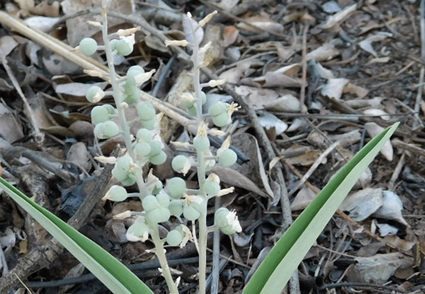Abstract
A new genus Occultia (Scilloideae, Asparagaceaae), is described from Malawi and Mozambique. One of the species on which this genus is based, was originally described as Hyacinthus. The genus is clearly separated from Ledebouria and closely related genera in characters of the flowers and the fruits. In Occultia tepals are united for 1/3 to ½ their length, the filaments are very short and inserted at the top of the perianth tube. In the fruiting stage, the tepals of the new genus become membranous and detached from their basis, but may form a cap on the developing capsule. In Ledebouria the tepals are free or united just at the base, the filaments are of a certain length and inserted at the base of the tepals. If persisting at fruiting stage the tepals are attached to the base of the capsule, and may become fleshy with time. The new genus comprises two species O. hyacinthoides and O. fragrans.
References
Flora of Mozambique (2021) Flora of Mozambique. Available from: https://www.mozambiqueflora.com (accessed 31 August 2021)
Flora of Zimbabwe (2021) Flora of Zimbabwe. Available from: https://www.zimbabweflora.co.zw (accessed 31 August 2021)
IPNI (2022) International Plant Names Index. The Royal Botanic Gardens, Kew, Harvard University Herbaria & Libraries and Australian National Botanic Gardens. Available from: http://www.ipni.org (accessed 15 March 2022)
Lebatha, P., Buys, M.H. & Stedje, B. (2006) Ledebouria, Resnova and Drimiopsis: a tale of three genera. Taxon 55: 643–652. https://doi.org/10.2307/25065640
Lindley, J. & Paxton, J. (1851) Drimiopsis. Paxton’s Flower Garden 2: 73.
Linnaeus, C. (1753) Species Plantarum, ed. 1, vol. 1. L.Salvius, Holmia, 560 pp.
Manning, J.C., Goldblatt, P. & Fay, M.F. (2004) A revised generic synopsis of Hyacinthaceae in sub-Saharan Africa, new combinations and the new tribe Pseudoprospereae. Edinburgh Journal of Botany 60: 533–568. https://doi.org/10.1017/S0960428603000404
Pfosser, M., Wetschnig, W., Ungar, S. & Prenner, G. (2003) Phylogenetic relationships among genera of Massonieae (Hyacinthaceae) inferred from plastid DNA and seed morphology. Journal of Plant Research 116: 115–132. https://doi.org/10.1007/s10265-003-0076-8.
PlantZAfrica (2021) Available from: http://pza.sanbi.org (accessed 31 August 2021)
Roth, A.W. (1821) Novae Plantarum Species praesertim Indiae Orientalis. Sumptibus H. Vogleri, Halberstad, 416 pp.
Stedje, B. & Kativu, S. (in press) Hyacinthaceae. Flora Zambeziaca.
Stevens, P.F. (2001 onwards) Angiosperm Phylogeny Website. Version 14, July 2017 (and more or less continuously updated since). Available from: http://www.mobot.org/MOBOT/research/APweb (accessed 31 August 2021)
Thiers, B. (2016) Index Herbariorum: A Global Directory of Public Herbaria and Associated Staff. New York Botanical Garden’s Virtual Herbarium. https://doi.org/10.1007/s12228-016-9423-7
Van der Merwe, F.Z. (1946) Aantekeninge vir die hersiening van die genus Scilla L. in Suid-Afrika. ‘n nuwe genus: Resnova. Tijdschrift voor de Wisen Natuurkundige Wetenschappen 6: 41–46.


